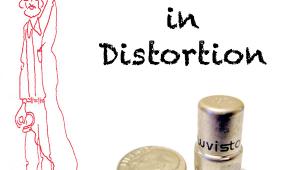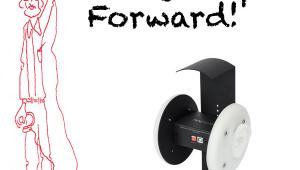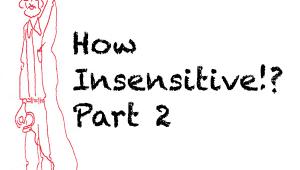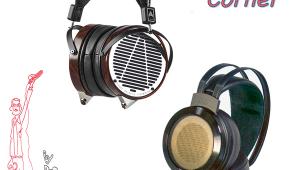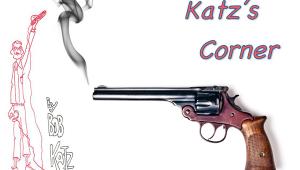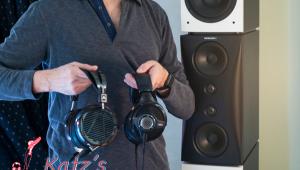| Columns Retired Columns & Blogs |
Katz's Corner Episode 24: Pass Labs HPA-1 Headphone Amplifier
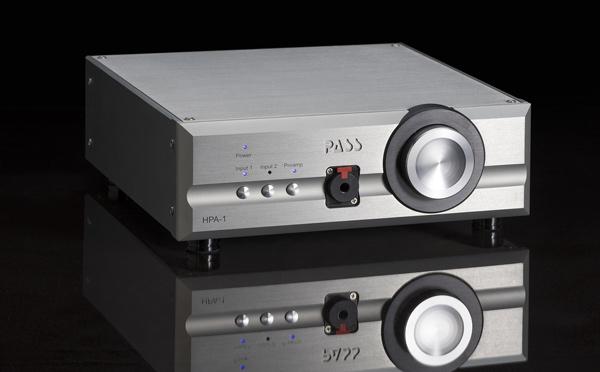
This story originally appeared at InnerFidelity.com
Fig. 1: Pass HPA-1 amplifier, front panel
Nelson Pass's Lab has produced an impeccable headphone amplifier with more than enough power, that's quiet, solid, and very clean. Several other reviewers have reflected on this excellent amplifier, but I want to weigh in with my unique sonic perspective and also measurements of its performance.
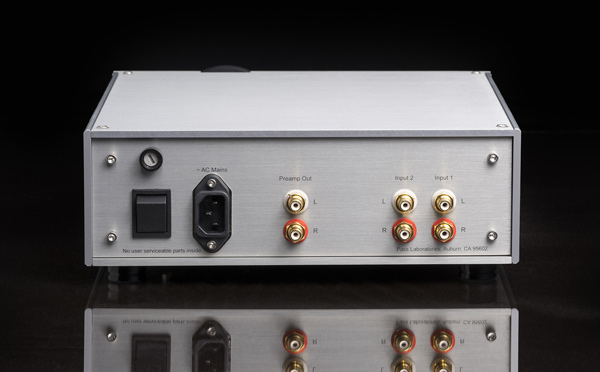
Fig 2: Pass HPA-1 amplifier, rear panel
The Pass's sculpted front panel is very pretty and makes a distinctive show piece; there's no need to hide this baby. The rest of the case consists of rectangular brushed aluminum panels. Its large, weighted volume control is unique in my experience—rotational feel is more solid than any other rotary control I've ever used. It's also very precise, as I measured nearly perfect channel matching, zero error (level difference) at full gain, 0.06dB error at 3 o'clock and 0.25dB error at 12 o'clock. Jam Somasundram, its designer, has made a very wise decision, to set the voltage gain to the absolute minimum to be compatible with any current headphone and DAC source. It's specified as only 6dB though I measured 7.6dB gain into 20 Ohms at 1kHz. Even with the volume control all the way to the top, there is no noise to be heard with the most sensitive headphones.
He has implemented an unbalanced circuit, with two selectable stereo RCA inputs and a locking 1/4" TRS jack, yet it delivers plenty of power, demonstrating that it is not necessary to have a balanced output to produce superior performance. An unbalanced amp needs a higher voltage power supply than a balanced amp with the same specification—however, the tradeoff is that fully-balanced requires double the components and an expensive, high precision 4-gang volume control. Balanced is strictly a designer's choice, not demonstrably superior (or inferior) to unbalanced—if the designers optimize the characteristics of each design. Ironically, most times Nelson Pass has advocated a fully-symmetrical approach in his products, but not in this headphone amplifier, which has a clean, minimalist design and few active components to pass the signal through.
Yes, balanced inputs may improve hum performance when very long connections are used, but that is not the case in most consumer's homes. Balanced outputs for headphones are absolutely not necessary, and even the use of the term is questionable—I prefer to say "push-pull" because headphones are floating, they do not have a ground reference. The amplifier also has line level outputs, available at the press of the "preamp" switch. The line-level preamplifier comes direct from the headphone circuit with the addition of a premium coupling capacitor. I did not listen to the preamp output but I did test its functionality. Pass's technical support engineer Kent English points out "One of the goals was to enable 'not yet audiophiles', allowing them to hear their own music better than they have heard it before....for the first time. In other words build something that appeals to the music lover first, number chasers second."
Jam, who is a very enthusiastic engineer, gave me some insight on the design: The HPA-1 was designed as a small power amp, requiring an oversized power transformer and a +/-24 Volt DC supply, while most headphone amps suffice with only +/- 15 volts. The low feedback, wide bandwidth amp has J-FET inputs and a direct-coupled MOSFET output stage, fully biased in Class A throughout. But unlike a loudspeaker amp a headphone amp has to meet a huge bunch of conflicting requirements. It has to drive a wide range of loads, from very sensitive headphones with as low as 15 Ohm impedance that require high current, to insensitive headphones with impedance as high as 600 Ohms that require high voltage drive. So after a certain point design choices become subjective, deciding the least compromise in each area to ensure low noise, low distortion, wide bandwidth and good sound.
For example, there is a balancing act between negative feedback and open loop gain as too much feedback results in a shallow midrange. There are no integrated circuits in the signal path. The power supply regulator is discrete, which Jam says sounds better than an integrated circuit. It took a full year to perfect the design, which included choice of components by listening. Eliminating unnecessary components was a conscious part of the design, and with its optimized gain and imperceptible noise, Pass has avoided the need for complex gain-set switches, that can introduce noise or distortion if not set properly.
Measurements
I made some basic measurements to confirm performance. Voltage gain (unloaded) to either the preamp or the headphone output was 8.25/8.28dB at 1kHz. Loaded by 20 Ohms, the output dropped by 0.62/0.54dB, indicating an output impedance of 1.45 Ohms (left channel) at 1kHz, close to its specification of "less than 2 Ohms". This moderate output impedance indicates that high negative feedback was not a design goal, so to obtain good linearity the designer had to begin with a very linear open-loop circuit.
With a 1kHz tone, 0dBu output into 110 Ohms (5.5mW) produces nearly all 2nd harmonic, at a level of -90/-90dBu, or 0.003% THD. We can see a trace of 3rd and 4th harmonic peeking above the noise floor in the left channel only, but at insignificant level. The rest is noise and hum (See Fig. 3). Keep in mind that second harmonic is the most innocuous and "invisible" harmonic inasmuch as it is exactly one octave above the fundamental. Besides, a level as significant as 0dBu would yield a ridiculously loud 101.72dB SPL in the Audeze LCD-4 headphones (according to manufacturer's specification). The very low second harmonic is at an inaudible 11.72dB SPL! The absence of other harmonics is a testament to the very linear design and promise of good sonics.
There are also visible hum-related products near the noise floor, at a higher level than I've seen in some other headphone amplifiers. Nevertheless, this hum is inaudible with any headphone I own. The noise floor measured -95.63/-95.77dBu unweighted, 10-20kHz, so it is also inaudible. I measured an acceptable crosstalk figure (110 Ohm load) of -70dB (in either direction) throughout the majority of the spectrum, rising to -55 at 20kHz. An IM test, 19/20kHz at a total of 0dBu into 110 Ohms produced a 1kHz difference tone at a very low-105dBu and supersonic sums circa 40kHz at -75dBu, which represents very good performance (fig 4). The rise in noise floor above 40kHz is due to my Prism interface's noise-shaped converter.
For frequency response, I can measure up to about 80kHz, and within that bandwidth, I measured the Pass's response (unloaded) as ruler flat from 10 Hz (where I began measuring) and slowly rolling off to -2.25/-2.5 at 80kHz at 0dBu output.
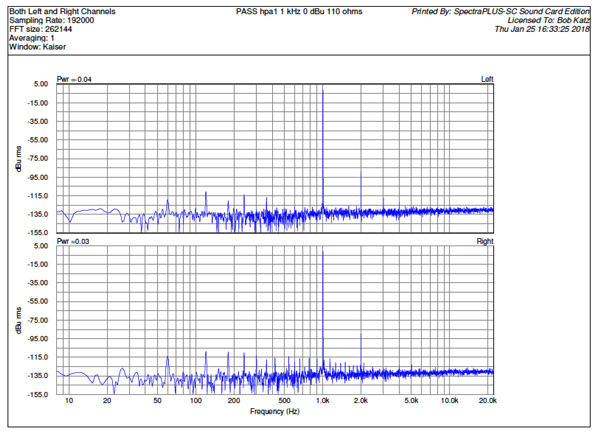
Fig. 3: Pass HPA-1 THD at 1kHz and noise
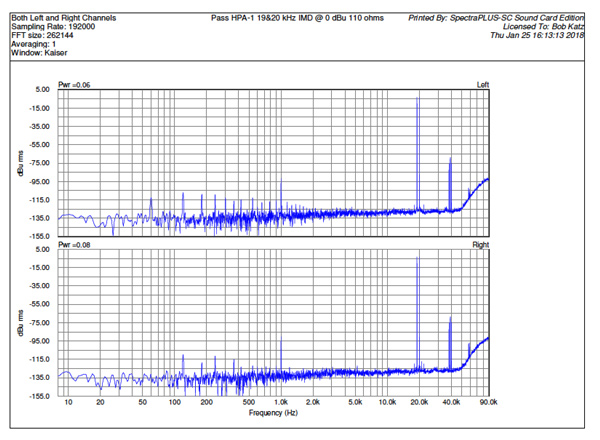
Fig 4: Pass HPA-1 IM distortion
While attempting to measure maximum power output I ran into the first "limitation" of the HPA-1's low gain: I could not drive the amplifier into clipping with the Prism Callia's unbalanced outputs, whose maximum level at full scale is 2V RMS (+8.23dBu), the same maximum output level as a consumer CD player. The reason I put the word "limitation" in quotes is that the Callia's unbalanced outputs at full scale can drive the HPA-1 to a very healthy 15.96/15.99dBu (1.18 watts) into 20 Ohms at 1kHz, yielding 0.1% THD and which would produce a deafening 127.8dB SPL at full scale even with the insensitive Audeze LCD-4. Not an advisable condition, so the Pass's low gain is not a limitation at all. If you insist on driving your eardrums into submission you'll need a DAC or preamp with a higher level output. You could also get 6dB more level with a balanced to unbalanced adapter. Not advised!
Nevertheless, I persisted. I switched to an interface with higher output level, the Prism Lyra, so finally I can confirm that the Pass clips, with 1.07/0.7% THD at 1kHz, +21.28/+21.30dBu (4 watts) into 20 Ohms, 1/2 a watt higher than the specification. For the record, that is equivalent to an even more deafening 133dB SPL (LCD-4) which would certainly damage headphones as well as ears in continuous testing. This is a measure of what the amplifier can deliver on peaks, so if we subtract a nominal 20dB, it would satisfy some mythical listener with mezzo-forte passages of 113dB! Fogedabodit.
The Listening
I warmed up the unit for several days. The sound definitely improves throughout the first day, and I swear even after the seventh day of continuous power it keeps on sounding better. Pass advocates leaving the power on 24/7. I decided to pit the sound of the HPA-1 against the Mjolnir Pure Bipolar as a reference that I'm familiar with. I matched the gain of the Mjolnir (balanced) and the Pass (unbalanced) within 0.1dB at 1kHz into a 110 Ohm load. The Pass volume control was set to full level and the Mjolnir ended up at about 3 o'clock. I built a high quality TRS male to XLR 4 pin female adapter so I could quickly exchange balanced headphones between the two amps.
I used JRiver Media Center on PC to play high resolution files into the Prism Callia DAC via AES/EBU from my Lynx interface. JRiver fed Acourate Convolver via Acourate ASIO's 64-bit connection so that I could insert my custom headphone EQ filters if I wished, but I listened with no EQ (flat) to all my tracks. With the Pass driven by the Callia's unbalanced output, I was able to produce a "loud" presentation of a well-recorded popular music piece at -11dB digital attenuation. Acourate Convolver dithers all its outputs, so there's nothing to fear from its digital attenuation. This leaves up to 11dB available gain, enough to play the softest, widest range classical music piece in my collection. By contrast, the Mjolnir had additional available analog gain, conceivably to play even softer music, but I have never seen any recording that would require it, so I am convinced that the Pass has adequate voltage gain to handle any music you might decide to feed it.
Lindsey Webster "Back To Your Heart"
This is one of my own masters, at 2496. It's a full-bodied, full range smooth jazz recording. With the Pass, the sound is very attractive, punchy and fat. The sound is subtly on the warm side: Lindsey's voice sounds warm and intimate. The cymbals are round, clear, yet extended. The ambience seems reasonably wide; I don't notice any loss of separation. Bass is solid and deep.
Switching to the Mjolnir, the sound is also clean, pure, and extended from bottom to top. The recording's ambience stretches pleasantly, it seems a bit more outside the cans than it was with the Pass. Vocal is perfectly centered within my head. All the clarity is there and it's driving the transients effortlessly. I'm quite surprised that the Mjolnir seems a tiny bit brighter than the Pass on this material since I expected it to sound warmer based on previous experience. Bass is big and beautiful. The snare pops. Cymbals are pure and tight. I don't feel we're missing any high end, even though I'm not using the headphone EQ that I'm accustomed to using with the LCD-4s and the Mjolnir.
Switching back to the Pass, I notice the sound level seems to have dropped just a hair. Aha, that's a clue to the sonic difference: I wager that the Pass sounds a hair softer (even though the levels were matched) because it is much cleaner, has far less harmonic distortion than the Mjolnir. This gives the Mjolnir an unfair loudness advantage. I don't think it will ever be fair to compare these two amps at matched 1kHz levels so it's perfectly possible that the sonic differences amount to the harmonic distortion contributing to a perceived loudness difference.
Either way, the sound of the Pass is extremely satisfying, warm, natural and beautiful, just not as bright circa 8-10kHz as the Mjolnir with this particular recording, but we're talking about the tiniest hair, so small that even an expert could not decide which presentation is more "right". There is no "right" when two amplifiers are both this good. And frankly, I could not pass a blind test to determine which amp is playing, as there is more similarity than difference when the two amps are matched at 1kHz.
San Francisco Symphony, West Side Story
For this gorgeous 24/96 recording from Blue Coast Records, I had to raise the digital gain by 6dB—attenuation is now at -5dB. On this recording, which I know to be bright-sounding on its peaks, the Mjolnir is a bit more forgiving as it saturates at higher levels and gets warmer via the additional 2nd and 3rd harmonic, while the Pass remains linear. So when the Jets chorus sings loudly, the vocals sound sweeter and more palatable on the Mjolnir than the Pass. But for the vast majority of this recording, except for the fortissimo passages, the Pass sounds beautiful, warm and pure.
It's critical to note that when I play this recording on my speakers, I EQ the high end down or it would sound bright and a bit harsh. So when playing it flat through the Pass I hear the same issues as on my speakers and amp. It's clear that the Pass amp is subtly on the warm side of accurate, and the Mjolnir on the euphonic side, at least on the loud passages. A bit of program EQ would fix the presentation of this recording on the Pass. Recordings differ and some of them need EQ. Live with that!
Janice Ian, Walking on Sacred Ground
This is from the album "Breaking Silence", transferred from the 16/44 CD. I began with my headphones on the Pass amp. This excellent recording, mastered by Doug Sax, brings goose bumps! Doug's great tube transfer chain really makes this recording sound beautiful, sweet and perfectly reproduced on the Pass. The highs and transients in this recording are still punchy and clear without getting fatiguing. This segues into Janis' "Ride Me Like a Wave", which also does not disappoint. This is a very pleasant listening experience. I do not switch the Mjolnir to compare.
"Do You Remember" by Jill Scott.
16/44 from the album "All or Nothing". This Neo Soul album's bass, in tandem with bass drum, goes down very deep. Her voice sounds warm and full on the Pass. The transients really move, and there's effortless power to spare. This a reference recording for the soul fanatic where the touch of hip-hop feel provides the "neo". I do not switch to the Mjolnir.
"Erienda", by Kenny Rankin
From the album "Because of You", direct from the 16/44 CD that I was the recording engineer for. I recorded this song with minimalist miking, primarily a Blumlein pair, in RCA's Studio A, New York City for Chesky Records with a tube chain and custom A to D Converter. Kenny's voice is just as I remember it, filling the hall so nicely. Highly recommended, if I may say so myself. The tone of all the instruments is just right on the Pass. It's pure pleasure. The ambience of Studio A is reproduced and extended well outside the phones. I do not switch to the Mjolnir.
"Speechless", by Laurie Anderson
This is from the CD "Bright Red". Recorded by the great Kevin Killen, mastered by Bob Ludwig, this a mesmerizing and perfect reference for audiophile fans of rock and performance art. Pick it up right away if you are a Laurie Anderson fan. Pick it up even if you don't know who Laurie Anderson is. The drums are among the best rock drums on any recording ever made, ever! The dynamics are impressive and the Pass does it perfect justice, extending the ambience well beyond the sides of my head. Bass drum goes down to the center of the earth, or at least my head. Mesmerizing. Did I already tell you that? I do not switch to the Mjolnir.
FB Pocket Orchestra, "I Lost My Girl from Memphis"
This swing combo is from my 2496 master of the album "Guerilla Jazz". The Pass reproduces the instrumental and percussion transients particularly well, making me rock involuntarily with the rhythm.
My impression is that the Pass is an impressive, impacting and musical headphone amplifier with absolutely no defects. It's musical, slightly on the warm side, yet extremely true to the source.
Matt and David Take a Listen
Let's check the perspective of a couple of young audio ears: my two assistants, Matt Davis and David Corson, with different tastes in music, so let's see how their favorites play on this amp. (I did suggest some of the tracks). Initially they listened without any headphone EQ. Again, amplifier levels matched within 0.1dB at 1kHz into a 110 Ohm load.
Vienna Philharmonic, Mahler Third, 2488 from HD Tracks
Matt - On this piece I can't hear any appreciable difference between the Mjolnir and the Pass.
David - The Pass is very similar in tone to the Mjolnir. Though it's really close, the Mjolnir has more impact and microdynamics than the Pass. But the tonality is too close to call.
Lindsey Webster, "Next to Me", 2496 Master
Matt - Pass: Dynamic presentation far surpasses the Mjolnir's. In the Mjolnir, the kick drum is more restrained. The vocal doesn't jump forward as much on her peaks. I'm not hearing the 3D quality: This may be because the Mjolnir's slightly warmer than the Pass as a lot of ambience is contained in the high end.
David - The Mjolnir seems to have a boost in the lows below about 100 and perhaps a bit more presence and microdynamics throughout the whole range.
FB Pocket Orchestra "I Lost My Girl from Memphis", 2496 Master
Matt - The Mjolnir has a harshness and a veiled quality compared to the Pass. The Pass is not brighter. The 6k sizzle in the tambourine favors the Pass over the Mjolnir. The Pass seems sweeter in the highs.
David - The Pass seemed warmer on this one, but did not have as much bottom. Makes me think the Mjolnir has a bit of a smile curve. [BK note: I think the apparent multi-personality of the Mjolnir is because of the sonic unpredictability of 2nd and 3rd harmonic distortion. Sometimes it can sound warmer, sometimes a bit brighter, sometimes more dynamic, sometimes less, depending on the content and the listener's orientation.]
Deepest Crystal Black, "And Where Now", hard rock, by IceCocoon, 2496 Master
Matt - The Mjolnir: This is a thick, closed in mix. The sound is flabby. In contrast, the Pass is leaner, translates better. The Mjolnir is muddy, the Pass is clearer. They both express the deep sub range approximately well, but the sonic differences in the low mids can prejudice the impression of the deep bass.
David - The Mjolnir seems to bring out the bass more as well as the vocals seem clearer, more presence.
Miles Davis "So What" from Kind of Blue, DSD upsampled in JRiver to 176.4
Matt - The distinctions are very subtle in this particular track. The two amps are very close. These two amps are more matched than not.
David - Seems similar to my previous reactions.
Ray Charles: "Here We Go Again", 2496 from "Genius Loves Company" Anniversary Edition
Matt Pass: Does not feel brighter. All signs would point to that since it has a clearer sonic signature. But it feels natural, kind of makes the Mjolnir feel like a murky amp. The Pass has more dimension.
David - Similar to my previous reactions.
Fahrenheit by Telefon Tel Aviv on Tidal – electronic music, aka "IDM" (intelligent dance music)
Matt - Even on something this extreme the Pass has a depth of field that I miss in the Mjolnir. But if I heard the Mjolnir on its own it would stand out well. This is not a glaring issue, a matter of (my) taste.
David - It feels like the Pass is a bit warmer here. But the bass is apparently emphasized in the Mjolnir.
Bruno Mars, 2496 MQA on Tidal "That's What I Like" from "24k Magic"
Matt - This is a nice, well-balanced master by Tom Coyne, a warm but incredibly punchy track, a great reference. My idea of a perfect EQ balance. There is an additional warmth in the Mjolnir that I don't hear in my studio. The Pass is a more present amplifier, and I hear the sound as I do on my system. This comes down to a matter of taste, which sound you prefer and why.
[Bob: Now I throw a monkey wrench in the works, my LCD-4 EQ] With the EQ, now this song feels thin with the Pass and the Mjolnir sounds more like the Pass did without EQ! It could be that the Pass is imparting a subjective Air band boost. The Mjolnir is more "tubey". The triode-like saturation in the Mjolnir can be desirable.
I really like the cleanliness of the Pass. The EQ helps the Mjolnir but I still can't shake the feeling that there's an alteration going on in the midrange. I can see some people seeking that character but in this range I seek neutrality. Most people would prefer the Mjolnir when Bob's headphone EQ is applied.
David - Similar reactions, except now the Pass seems warmer from 60 through 500. But the really thumpy bass is greater on the Mjolnir.
Summary
Matt enthusiastically preferred the Pass to the Mjolnir. Matt and David sometimes differed in their reactions, a matter of taste, but keep in mind the Mjolnir was designed to emulate a classic triode circuit, which saturates a bit as things get loud. Single tone tests on the Mjolnir show predominance of 2nd and 3rd harmonic. However, harmonic distortion is a funny beast, sometimes it can manifest itself as presence, sometimes as warmth, and often as fat bass, very dependent on the material, so I'm not surprised at the sometimes apparently contradictory reactions depending on the musical source. Distortion is compression, it can subjectively soften dynamics, but when it's enhancing a range, that range can seem louder and counter intuitively dynamics can appear to increase.
There is enough evidence here that the Pass is the more robust amp and technically the more dynamic of the two amps. We also present some interesting evidence that if you adjust EQ for a headphone, be sure to pick the amplifier you are going to use with this EQ. In fact, when EQ was applied, suddenly one amplifier seemed to take on some of the personality of the other. Harmonic distortion can sound a lot like EQ.
In summary, if you like your sound tight, impacting, clear, accurate and transparent with a nice taste of warmth, I would highly recommend the Pass HPA-1. If you like an amplifier that's a bit more forgiving, especially with harsh sources, I would lean towards recommending the Mjolnir. I would not kick either amplifier out of bed!
- Log in or register to post comments
